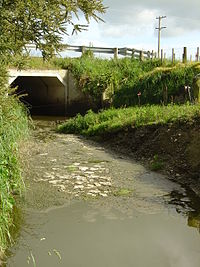
Photo from wikipedia
1 In the northeastern United States, it is common for dairy farmers to apply manure throughout the fall due to typical 6-mo manure storage limitations, time constraints, spring soil moisture… Click to show full abstract
1 In the northeastern United States, it is common for dairy farmers to apply manure throughout the fall due to typical 6-mo manure storage limitations, time constraints, spring soil moisture and compaction concerns (Meisinger and Jokela, 2000), and crop nutrient needs. Although there are practical benefits for farmers, lack of vegetative growth and nutrient uptake make fall and winter manure applications environmentally riskier than applications in spring and summer when crops are actively growing. Fall applications are of particular concern in the Chesapeake Bay, where agricultural sources have been identified as a primary contributor of P and N to the Bay, causing hypoxic conditions that threaten aquatic organisms, human health, and overall water quality (Howarth et al., 2000; Smith, 2003; Verhoeven et al., 2006; Frumin and Gildeeva, 2014). Several states within the Chesapeake Bay have manure management guidelines that restrict applications (Srinivasan et al., 2006; Liu et al., 2018). For instance, Pennsylvania permits fall and winter manure applications, but requires a minimum of 25% ground cover, residue, or established cover crop; or manure must be injected or mechanically incorporated within 5 d using minimal soil disturbance techniques consistent with no-till farming practices (Pennsylvania Code, 2005). An established cover crop can reduce N leaching losses to the environment compared to bare fields (Tonitto et al., 2006; Martinez-Feria et al., 2016; Hanrahana et al., 2018). A metaanalysis of 69 non-legume cover crop studies consisting mostly of winter rye (75% of studies) found that cover crop uptake of inorganic N averaged 37 kg N ha–1 and reduced leaching by 70% compared to bare fallow across a wide range of climate and management systems (Tonitto et al., 2006). In northeastern climates where planting windows are short, winter rye is an ideal species for establishing after corn or soybean (Glycine max L.) (Starzycki, 1976). In addition to being cold tolerant, winter rye is a N Influence of Dairy Slurry Manure Application Method, Fall ApplicationTiming, and Winter Rye Management on Nitrogen Conservation
Journal Title: Agronomy Journal
Year Published: 2019
Link to full text (if available)
Share on Social Media: Sign Up to like & get
recommendations!